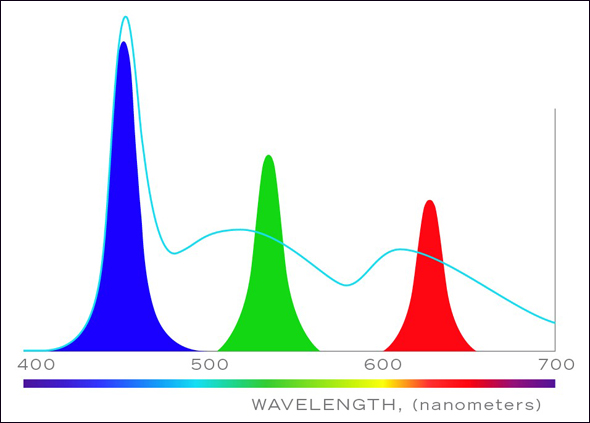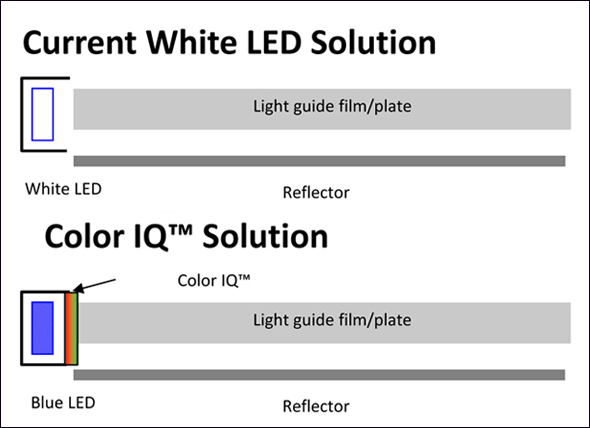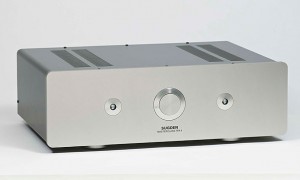Mr. David Susilo, PhD: ISF, Control4, CEDIA,
THX Certified Professional and HAA Member.
At CES in January, Sony re-introduced Triluminos backlighting system that used to be employed in their XBR8 TVs in 2008. However, this new backlighting method that they promise is no longer the multiple-colour LED to create the backlighting but utilizes an optical component produced by QD Vision, Inc. called “Color IQ” which uses quantum dots to help create light.
OK, so what are quantum dots?
Quantum dots are a “semiconductor nano-crystal technology” where tiny pieces of matter with unique properties, including the ability to emit light at very specific wavelengths. Sort of like microscopic pieces of glitter that glow green, red, or blue depending on their size.
 Red, green, and blue spectrums for blue, green, and red quantum dots.(Credit: QD Vision)
Red, green, and blue spectrums for blue, green, and red quantum dots.(Credit: QD Vision)
All LCDs create these colors with filters. Plasma displays create them with phosphors that glow in the required color (similar to the way CRT tube TVs worked). OLED, depending on the company, is one or the other. LG’s method creates a “white” OLED then adds color filters (this is what I consider as “fake” OLED TV because essentially this TV will just be another LCD TV that uses WOLED backlighting instead of LED or CCFL). Samsung’s, Sony’s and Panasonic’s method has specific red, green, and blue OLED sub-pixels.
So where do quantum dots come in? Sony has a method.
Sony’s X900 and W900 lines
Three of Sony’s 2013 TVs will use quantum dots in their backlighting, in the guise of QD Vision’s Color IQ tech (the 65X900, 55X900, and 55W900). A traditional LED LCD uses blue LEDs, coated with a yellow phosphor, to create “white” light. While reasonably efficient compared to other technologies (i.e. CCFL LCDs and plasmas), this still creates a lot of “wasted” energy. Orange, for example, doesn’t make it past the color filters on the front of the TV (instead, red and green are combined to create orange).
Triluminos uses blue LEDs, but instead of coating them with a yellow phosphor, the blue light from the LEDs passes through the Color IQ optical element containing red and green quantum dots. So the blue LEDs have two functions: create blue light, but also energize red- and green-emitting quantum dots so they in turn can create red and green light. About two-thirds of the light created by the blue LEDs is used to excite the QDs.
 This diagram is a top-down view of one side of two edge-lit LCDs (the front is “up” in this case,
This diagram is a top-down view of one side of two edge-lit LCDs (the front is “up” in this case,
the back is “down”). The upper image shows a traditional “white” LED (blue, with yellow phosphor).
The lower image is the method used in Sony’s Triluminos: a blue LED that passes through
red and green quantum dots. This RGB light bounces off the light guide, and out through the liquid
crystal and other layers just like a regular LCD TV.(Credit: QD Vision)
How dots can help TV colour rendition
Sony claims its new backlight technology allows for a wider color gamut compared to LCD TVs using “white” LEDs, as in more potential colors. Since all modern TVs are fully capable of reproducing every colour in all current HDTV content, this is a bit of marketing hyperbole.
However, the benefits of this could go beyond cool, futuristic tech and marketing. When I’ve reviewed LED-lit projectors, I’ve found that the color possible from RGB LEDs looks more realistic than the same SMPTE/THX/ISF/Rec. 709-calibrated colours created by colour filters (DLP) or dichromatic mirrors (LCD/LCOS) as lit by UHP lamps. One TV engineer I asked about this phenomenon replied “LEDs are like painting with purer paint.”
I often remarks in my observations on the bluish cast seen on most (if not all) conventional LED-based TVs compared to plasma sets. It’s usually most prevalent in dark areas, but often times I still see a slight bluish ‘coldness’ in brighter material and skin tones too. In some cases I still see it despite the seemingly excellent color measurements from my calibration instruments.
So it’s possible that even with the same measured color points, quantum dot-enhanced displays could produce more realistic color. Will they? Will the color mixing required to create Rec. 709 from wildly oversaturated color points cause other issues? What effect will the color filters, which are still necessary on LCDs, have on this “purer” light? These are questions I can’t answer until I review the X900 series and any future TVs with quantum dots.
The current generation of quantum dot technology requires a primary light source like the blue LEDs in Sony’s Triluminos. This won’t always necessarily be the case. It will be possible to excite the quantum dots directly. This could be a full QD backlight, but it could be more. How about a direct-emissive display like OLED but instead of using Organic Light-Emitting Diodes, its sub-pixels filled with red, green, or blue quantum dots. QD Vision calls this a “QLED,” and it could have similar performance characteristics as OLED (such as truly infinite contrast ratio IF they are used in a full-backlight fashion and not only the edge-lit like today). Will it be easier to produce, offer better color, or have even lower power consumption? At this point, I have no idea. One thing for sure, however, unlike the premature death of blue pixels in OLED displays, Quantum Dots will NOT have that problem.



